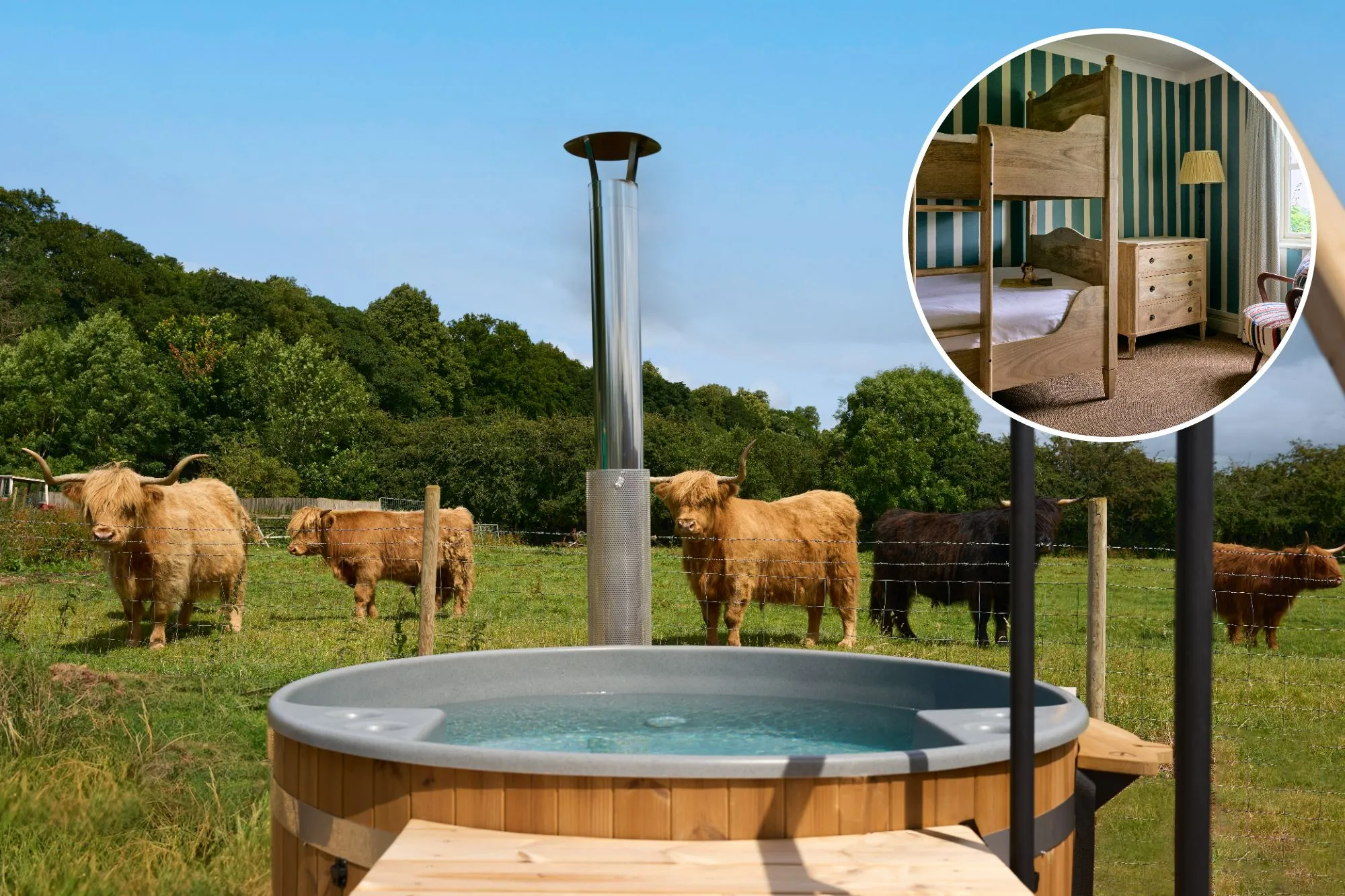Mirror reporter Julia Banim enjoyed a winter spa break at A-list favourite and foodie haven Carden Park, and a little bit of drizzle did nothing to dampen her spirits
With Christmas fast approaching, I was fortunate enough to enjoy a winter spa break at a hotel beloved by celebs, and I’m happy to say it’s not down south.
Nestled in the Cheshire countryside, Carden Park is reportedly a favourite of A-lister couples such as Ryan Reynolds and Blake Lively, as well as Molly-Mae Hague and Tommy Fury. And the spa garden, complete with jacuzzis, fire pits, and heated glass pods, may well leave you feeling like you’re on a very high-end version of Love Island.
Back when I’m A Celebrity was filmed in North Wales during the pandemic, Carden Park even served as a plush eviction hotel for booted off campmates. It must have felt like a true haven for contestants after their insect infested ordeal, but what does this glam retreat have to offer for an average Joe such as myself?
READ MORE: EasyJet currently has flights from £23.99 to heaps of winter sun hotspots for 2026
Situated in complete seclusion amid lush green grounds, it’s no wonder that stars favour this haven of relaxation, which feels a world away from the bustle of city life. But, with pretty Chester and the bargain heaven that is Cheshire Oaks just around the corner, shopaholics won’t have much to complain about.
If you listen carefully during the sweeping drive through the grounds, you may well hear the gentle putt of a golf ball, but today, I’m in no mood for sport. It’s time to completely unwind and put all the stresses of the dark and gloomy season aside.
The spa building is separate from the hotel, an elegant, immaculate building which smells heavenly. The staff are warm and welcoming, and the bathrobes are soft and fluffy. I’m here on a girls’ weekend with my mum and my sister, and I can’t think of a better place to natter the day away over some celebratory fizz.
Now, stripping to your swimsuit on a drizzly November day isn’t for the faint-hearted, but I can assure you that once you slip your shoulders under the waters of the vitality pool, you’re absolutely away.
The sky is clear and blue, and I can barely tear myself away from my tranquil spot for my spa treatment, a wonderfully indulgent 50-minute Time-to-Pause ritual treatment, which left my sunlight-deprived skin glowing and petal soft.
Admittedly, I sometimes struggle to drift off during spa treatments and find myself anxiously making to-do lists in my head, but here I found myself almost completely disconnected from the world.
It certainly helps that, after you’re done with treatments, you have a choice of relaxation rooms to unwind in before entering reality. This includes a sensory room, complete with soothing screen, and, my personal favourite, the deep relaxation room, where the crackling fire offered a very seasonal feel.
Famished from all my ‘lady of leisure-ing’, I head for lunch at Elements, where we enjoy matching, and tasty, Tandoori Chicken Open Sandwiches overlooking the spa garden, washed down with some of the most delicious peach mimosas I’ve ever had. Any future visitors should make sure to grab a portion of the salt and pepper chips – a truly sensational side, and even better than your favourite chippy.
Even in what can feel like the greyest time of the year, the floor-to-ceiling windows let in plenty of light, and for a moment I feel as though we were back on holiday with a whole week of sunshine ahead of us.
The waiters also couldn’t be more lovely, even phoning down to the spa garden’s Bollinger champagne bar to ensure we had hot chocolate treats waiting for us when we returned. Very welcome when wearing flips in November.
Full from our hearty lunch, we head back down to the spa garden, to luxuriate in one of the glass pods with our hot chocs. Although we are already quite comfortable, a member of the bar staff came over with cuddly hot water bottles for us – a very sweet touch.
The bar is described as running in ‘all-weather’, and we certainly didn’t feel any less pampered for a bit of chill. That being said, we are Northern, and Southerners may well feel differently.
The afternoon soon melts away as we set about the very important task of trying out the spacious jacuzzis, plus the outdoor sauna, with its floor-to-ceiling window. It’s life I could very easily get used to. While we don’t mind a spot of drizzle, when it starts to rain, we head inside to the Indoor Thermal Suite.
While I would be more than happy with just the one sauna, Carden Park offers a relative gallery of thermal experiences, from a Finnish sauna to a Tepidarium, all encircling a sparkling ice fountain.
There are even two steam rooms to choose from – salt and aroma. I particularly enjoy the indoor vitality pool, which looks out over the garden and offers gorgeous therapeutic jets of bubbles.
I could happily float around gossiping in the vitality pool for hours, but it’s time to dry off and get glammed up for the next part of our dreamy day – dinner. We’re set to dine at Carden Park’s award-winning à la carte restaurant, The Vines, which has a swish yet welcoming feel.
Typically of me, I’ve forgotten my posh shoes and have to borrow some smart boots from my much more organised mum (this isn’t somewhere you stomp in with your muddy trainers!).
I am touched, however, by staff reassurances that they would have sorted me out with suitable shoes in a pinch, which definitely helps alleviate my embarrassment.
Carden Park Hotel is tastefully decorated, with a cosy feel perfect for blustery winter nights. But The Vines elevates this to a whole new level of elegance. Atmospheric, yet never daunting, we are made to feel at home, and there is a gently lively buzz to the room. The sort of sparkle you hope for any chatty girls’ night, albeit far posher than my usual Saturday.
The staff, are friendly and attentive, – an ongoing theme – while every single course on our taster menu is nothing short of superb. Even the freshly baked bread and butter is memorable.
There’s a real northern, comforting sense to the menu – the BBQ Cheshire Venison Loin is sublime – and there’s plenty of experimentation, with intriguing flavour inspirations from far and wide.
The roasted monkfish on the bones, served with bombay potatoes and a tasty coconut and kaffir lime sauce, is a real highlight. And I have to admit, even though I initially feel a little squeamish tucking into the chicken & rabbit galantine, this is dreamy.
Each dish is paired with a delicious drink, explained to us by the very knowledgable sommelier. I particularly love how creative these pairings were, with the sweet Hungarian Tokaji wine, which accompanies the caramelised apple pie, being my absolute favourite.
It’s always a surprise to me that this honeyed drink, which I can’t get enough of when in Budapest, hasn’t become fashionable among chic sorts in the UK yet.
In terms of my personal ranking, this is closely followed by the Brown Butter XO cocktail, served alongside the Banana & Popcorn Iced Parfait, which tastes like a desert in itself. There should be far more buttery cocktails in my opinion.
Although I try to pace myself, this is a table filled with temptation and I happily enjoy every drop. Really, is there a more blissful evening than sitting with two of your favourite people, enjoying a range of novel yet tasty treats? I think not.
When the time comes to leave the restaurant, I practically waddle to my room. I have a large appetite, and proud of it, but this hearty taster menu has defeated me. Thankfully, my room is clean, comfortable and with deep plush pillows. I’m soon enjoying the easy sleep of the truly rested.
Although I’ve enjoyed some lovely spa days in my time, I have to say nothing has ever come close to Carden Park. The setting is idyllic, the facilities are extensive, and every inch feels immaculate and well thought out.
Not to mention, the culinary experiences on offer are just as special as those found in the spa treatment rooms. Foodies, bring your appetites.
I will treasure my memories of Carden Park, and wholeheartedly recommend it as a winter bolthole, whether for a pre-Christmas getaway or January detox.
There are currrently plenty of packages on offer, including the Indulgent Spa Day pacakge for £299, and the A Little Winter Love Morning Spa Experience for £195. Find out more on the Carden Park website.
Do you have a story to share? Email me at julia.banim@reachplc.com
READ MORE: ‘Great quality’ £3k diamond watch that’s ‘almost identical to Cartier’ is now under £200










